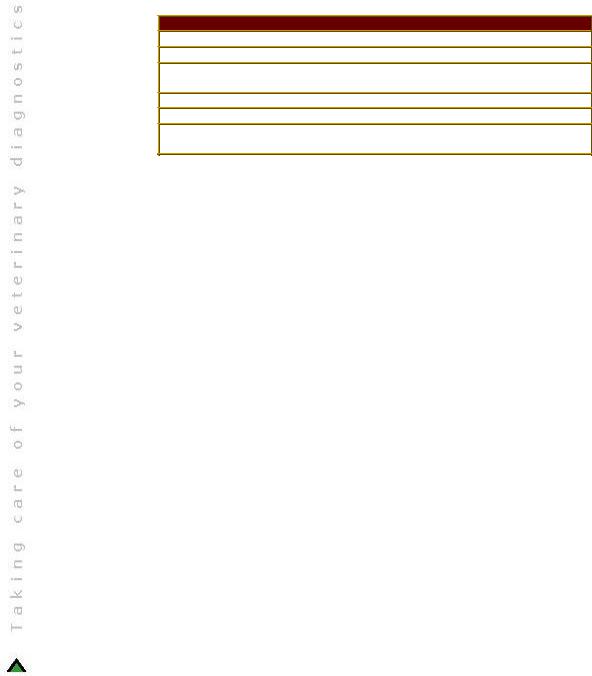
Quality Sampling Techniques_Serum Samples
.pdf
Q u a l i t y S a m p l i n g T e c h n i q u e s - S e r u m S a m p l e
CTDS Ltd.
Blacksmiths Forge, Brookfield Farm,
Selby Road, Garforth.
W. Yorks. LS25 1NB
Tel: |
0113 287 0175 / 6259 |
Fax: |
0113 286 5127 |
Email: |
info@ctdslab.co.uk |
Web: |
www.ctdslab.co.uk |
Taking Quality Samples – Sheet 1 – Serum Samples
Serum
Serum is the fluid that is left when blood has been allowed to clot and the cellular material has been removed. Normal serum is clear and has a pale yellow appearance.
Tests requiring serum samples.
Serum samples are used for most biochemistry tests, endocrinology, serology, therapeutic monitoring, allergy and serological tests. (Refer to CTDS “Sample Requirements List” for a comprehensive list of test requirements, or contact the laboratory for assistance).
Serum tubes
Blood must be taken into tubes containing NO anticoagulant. Serum tubes present in two sorts those which are plain and usually have a clear top and those which contain an inert gel to aid sample separation (brown top tube).
Good sample techniques
Sample collection
A standardised approach to sampling and laboratory testing is essential when comparing patient results collected at different occasions and appropriate sampling techniques can minimise both costs and patient discomfort by reducing the need for repeat tests.
In the dog and cat blood is frequently collected from either the jugular or cephalic vein and there are advantages to both sites (see below) although jugular venepuncture is preferred by CTDS.
Jugular venepuncture |
Cephalic venepuncture |
|
Shorter collection time |
Longer collection time can lead to the initiation of clotting |
|
process |
||
|
||
Larger volume of blood |
Smaller blood volume available |
|
Can use a larger bore needle and reduce the risk of |
Often requires a smaller bore needle and increased risk |
|
haemolysis |
of haemolysis |
|
Considered a more "difficult technique" and needs |
Vein used commonly and therefore more familiar |
|
more practice |
||
|
||
Leaves cephalic vein available for other treatment |
|
Patient preparation and sample quality.
∙Stress can affect laboratory results, most commonly causing leucocytosis in young cats and hyperglycaemia in both cats and dogs.
∙Sampling should preferably be performed prior to drug administration including therapy, when this is not possible the drug treatment should be included in the clinical history.
∙Fasting - as a general rule an 8-12 hour fast is preferred (except in neonatal patients where this is not advisable) prior to biochemistry and haematology profiling (N.B. - fasting is not necessary prior to Total T4 (Thyroxine) assays at CTDS - please contact the lab if you are unsure as to which assays are affected and which are not).
∙Lipaemia is the milky opacity that occurs when triglyceride levels are particularly high, most commonly occurs in samples collected 2-6 hours post feed although in patients with endocrine disease these levels may persist for longer. Although as a general rule we don't recommend that you submit lipaemic samples we appreciate that in certain cases and disease conditions you have no option. At CTDS we grade the lipaemia as either mild (+), moderate (++) or marked (+++) dependant on the
Contd……
Company Registration Number: 4963185. VAT Registration Number: 831905729. |
ctdsserumqualitynov2004 |

∙triglyceride content and attempt to remove the lipid by a series of -70 C freeze/thaw and rapid centrifugation techniques.
∙Lipaemia affects many biochemistry tests and also can also affect automated haematology counts.
∙Lipaemic samples are also more likely to become haemolysed upon standing so serum separation at the time of sampling is even more critical in these cases.
∙Generally a larger sample volume is required for lipaemic samples since a) they give a smaller serum yield b) some serum is lost by freeze/spinning and c) analytical methods often involve reruns and dilutions to generate results.
∙Haemolysis is the red discolouration of serum / plasma caused by the leakage of haemoglobin from red cells. It can affect some biochemistry tests and may be caused by poor sample techniques or a failure to separate the serum/plasma prior posting or storage.
Common causes of haemolysis
Vigorous shaking of samples
Exposure of samples (unseparated) to excessive temperatures
Use of fine gauge needles during venepuncture and / or failure to remove needle prior to ejecting the sample into the sample tubes
Excessive pressure on the syringe plunger during sample collection
Haemolytic anaemia's
Failure to separate serum or plasma from the red cells prior to postage or storage (see serum gel tubes below)
As a general rule serum samples should be submitted for all profiles and screens as well as endocrinology, biochemistry, drug monitoring and most serological tests. Serum is the fluid part of blood that remains when it has been allowed to clot and in healthy animal’s serum should be clear and a pale yellow, straw colour although horses and reptiles may have yellow serum - "icteric" - as a norm.
Use of serum gel tubes
When red blood cells remain in contact with the serum, autolysis occurs and intracellular contents leak into the serum. This can affect biochemistry analysis and induce erroneous results and eventually the red cells may lyse causing haemolysis. While many tests are affected by haemolysis, potassium, total bilirubin and phosphorous are most affected. We recommend the use of serum gel tubes since, after centrifugation, the gel forms an impermeable barrier between the red cells and the serum and thus helps prevent leakage of intracellular material into the serum. If separated correctly there is no need to decant the serum further.
Protocol:
∙Take blood sample and fill the labeled gel tube slowly - having first removed the needle from the syringe.
∙Allow the blood to clot for approximately 30 minutes (1 hour for equines and exotics).
∙Centrifuge the tube at high speed for 5-10 minutes ensuring that after centrifugation the gel has formed a clear barrier between the cells and the serum (3). (If this has not happened then recentrifuge, as the most likely cause of this is that the blood had not fully clotted prior to centrifugation).
∙Submit the serum tubes with request and any other tubes to CTDS.
Company Registration Number: 4963185. VAT Registration Number: 831905729. |
ctdsserumqualitynov2004 |
